Application of a Novel Hybrid Wavelet-ANFIS/Fuzzy C-Means Clustering Model to Predict Groundwater Fluctuations
Abstract
1. Introduction
2. Materials and Methods
2.1. Study Area
2.2. Data Description
2.3. Completion of Groundwater Level Missing Values
2.4. Training and Testing of GWL Prediction Models
2.5. Adaptive Neuro Fuzzy Inference System (ANFIS)
2.6. Fuzzy C-Means (FCM) Clustering Method
2.7. Wavelet Transformation
2.8. Hybrid Wavelet-ANFIS Model
3. Results and Discussion
4. Conclusions
Author Contributions
Funding
Institutional Review Board Statement
Informed Consent Statement
Data Availability Statement
Conflicts of Interest
References
- Koch, M. Challenges for future sustainable water resources management in the face of climate change. In Proceedings of the 1st NPRU Academic Conference, Nakhon Pathom University, Nakhon Pathom, Thailand, 23–24 October 2008. [Google Scholar]
- Nayak, P.; SatyajiRao, Y.; Sudheer, K. Groundwater level forcasting in a shallow aquifer using artificial neural network. J. Water Resour. Manag. 2006, 20, 77–90. [Google Scholar] [CrossRef]
- Jolly, I.D.; McEwan, K.L.; Holland, K.L. A review of groundwater–surface water interactions in arid/semiarid wetlands and the consequences of salinity for wetland ecology. Ecohydrology 2008, 1, 43–58. [Google Scholar] [CrossRef]
- Prinos, S.T.; Lietz, A.C.; Irvin, R.B. Design of a real-time groundwater level monitoring network and portrayal of hydrologic data in Southern Florida. In USGC Water Resources Investigations Report; Geological Survey (US): Reston, WV, USA, 2002. [Google Scholar]
- Lijun, F.; Shuquan, L. Forecasting the runoff using least square support vector machine. Tianjin Teach. Comm. 2007, TJGL06-099, 884–889. [Google Scholar]
- Nourani, V.; Alami, M.T.; Aminfar, M.H. Combined neural—Wavelet model for prediction of Ligvanchayi watershed precipitation. Eng. Appl. Artif. Intell. 2009, 22, 466–472. [Google Scholar] [CrossRef]
- Behzad, M.; Asghari, K.; Coppola, E.J.R. Comparative study of SVMs and ANNs in aquifer water level prediction. J. Comput. Civ. Eng. 2010, 24, 408–413. [Google Scholar] [CrossRef]
- Yoon, H.; Jun, S.C.; Hyun, Y.; Bae, G.O.; Lee, K.K. A comparative study of artificial neural networks and support vector machines for predicting groundwater levels in a coastal aquifer. J. Hydrol. 2011, 396, 128–138. [Google Scholar] [CrossRef]
- Shiri, J.; Kisi, O.; Yoon, H.; Lee, K.-K.; Hossein Nazemi, A. Predicting groundwater level fluctuations with meteorological effect implications—A comparative study among soft computing techniques. Comput. Geosci. 2013, 56, 32–44. [Google Scholar] [CrossRef]
- Mirzavand, M.; Khoshnevisan, B.; Shamshirband, S.; Kisi, O.; Ahmad, R.; Akib, S. Evaluating groundwater level fluctuation by support vector regression and neuro fuzzy methods: A comparative study. Nat. Hazards 2015, 102, 1611–1612. [Google Scholar] [CrossRef]
- Zare, M.; Koch, M. Groundwater level fluctuations simulation and prediction by ANFIS- and hybrid Wavelet-ANFIS/Fuzzy C-Means (FCM) clustering models: Application to the Miandarband plain. J. Hydro-Environ. Res. 2018, 18, 63–76. [Google Scholar] [CrossRef]
- Srivastav, R.K.; Sudheer, K.P.; Chaubey, I. A simplified approach to quantifying predictive and parametric uncertainty in artificial neural network hydrologic models. Water Resour. Res. 2007, 43. [Google Scholar] [CrossRef]
- Jang, J.S.R. ANFIS: Adaptive-network-based fuzzy inference system. IEEE Trans. Syst. Man Cybern. 1993, 23, 665–685. [Google Scholar] [CrossRef]
- Shiri, J.; Kisi, O. Comparison of genetic programming with neuro-fuzzy systems for predicting short-term water table depth fluctuations. Comput. Geosci. 2011, 37, 1692–1701. [Google Scholar] [CrossRef]
- Amutha, R.; Porchelvan, P. Seasonal prediction of groundwater levels using ANFIS and radial basis neural network. Int. J. Geol. Earth Environ. Sci. 2011, 1, 98–108. [Google Scholar]
- Moosavi, V.; Vafakhah, M.; Shirmohammadi, B.; Ranjbar, M. Optimization of Wavelet-ANFIS and Wavelet-ANN Hybrid Models by Taguchi Method for Groundwater Level Forecasting. Arab. J. Sci. Eng. 2014, 39, 1785–1796. [Google Scholar] [CrossRef]
- Wen, X.; Feng, Q.; Yu, H.; Wu, J.; Si, J.; Chang, Z.; Xi, H. Wavelet and adaptive neuro-fuzzy inference system conjunction model for groundwater level predicting in a coastal aquifer. Neural. Comput. Appl. 2015, 26, 1203–1215. [Google Scholar] [CrossRef]
- Emamgholizadeh, S.; Moslemi, K.; Karami, G.H. Prediction the groundwater level of Bastam Plain (Iran) by Artificial Neural Network (ANN) and Adaptive Neuro-Fuzzy Inference System (ANFIS). Water Resour. Manag. 2014, 28, 5433–5446. [Google Scholar] [CrossRef]
- Khaki, M.; Yusoff, I.; Islami, N. Application of the Artificial Neural Network and Neuro-fuzzy System for Assessment of Groundwater Quality. Clean Soil Air Water. 2014, 42, 1–10. [Google Scholar] [CrossRef]
- Rajaee, T.; Ebrahimi, H.; Nourani, V. A review of the artificial intelligence methods in groundwater level modeling. J. Hydrol. 2019, 572, 336–351. [Google Scholar] [CrossRef]
- Zare, M.; Koch, M. Using ANN and ANFIS Models for simulating and predicting groundwater level fluctuations in the Miandarband Plain, Iran. In Proceedings of the 4th IAHR Europe Congress, Liege, Belgium, 27–29 July 2016; pp. 416–423. [Google Scholar]
- Vaidhehi, V. The role of Dataset in training ANFIS system for course Advisor. Int. J. Innov. Res. Adv. Eng. 2014, 1, 249–253. [Google Scholar]
- Mirrashid, M. Earthquake magnitude prediction by adaptive neuro-fuzzy inference system (ANFIS) based on fuzzy C-means algorithm. Nat. Hazards 2014, 74, 1577–1593. [Google Scholar] [CrossRef]
- Kuczera, G. Uncorrelated measurement error in flood frequency inference. Water Resour. Res. 1992, 28, 183–188. [Google Scholar] [CrossRef]
- Sang, Y.F.; Wang, D.; Wu, J.C.; Zhu, Q.P.; Wang, L. The relation between periods’ identification and noises in hydrologic series data. J. Hydrol. 2009, 368, 165–177. [Google Scholar] [CrossRef]
- Donoho, D.H. De-noising by soft-thresholding. IEEE Trans. Inform. Theory 1995, 41, 613–617. [Google Scholar] [CrossRef]
- Elshorbagy, A.; Simonovic, S.P.; Panu, U.S. Noise reduction in chaotic hydrologic time series: Facts and doubts. J. Hydrol. 2002, 256, 147–165. [Google Scholar] [CrossRef]
- Torrence, C.; Compo, G.P. A practical guide to wavelet analysis. Bull. Am. Meteorol. 1998, 79, 61–78. [Google Scholar] [CrossRef]
- Jansen, M. Minimum risk thresholds for data with heavy noise. IEEE Signal Process. Lett. 2006, 13, 296–299. [Google Scholar] [CrossRef]
- Nourani, V.; Hosseini Baghanam, A.; Adamowski, J.; Kisi, O. Applications of hybrid wavelet–Artificial intelligence models in hydrology: A review. J. Hydrol. 2014, 514, 358–377. [Google Scholar] [CrossRef]
- Nourani, V.; Alami, M.T.; Daneshvar Vousoughi, F. Wavelet-entropy data pre-processing approach for ANN-based groundwater level modeling. J. Hydrol. 2015, 524, 255–269. [Google Scholar] [CrossRef]
- Ebrahimi, H.; Rajaee, T. Simulation of groundwater level variations using wavelet combined with neural network, linear regression and support vector machine. Glob. Planet. Chang. 2016, 148, 181–191. [Google Scholar] [CrossRef]
- Barzegar, R.; Fijani, E.; Asghari Moghaddama, A.; Tziritis, E. Forecasting of groundwater level fluctuations using ensemble hybrid multi-wavelet neural network-based models. Sci. Total Environ. 2017, 599–600, 20–31. [Google Scholar] [CrossRef]
- Malekzadeh, M.; Kardar, S.; Saeb, K.; Shabanlou, S.; Taghavi, L. A novel approach for prediction of monthly ground water level using a hybrid wavelet and non-tuned self-adaptive machine learning model. Water Resour. Manag. 2019, 33, 1609–1628. [Google Scholar] [CrossRef]
- Shirmohammadi, B.; Moradi, H.; Moosavi, V.; Semiromi, M.T.; Zeinali, A. Forecasting of meteorological drought using Wavelet-ANFIS hybrid model for different time steps (case study: Southeastern part of east Azerbaijan province, Iran). Nat. Hazards 2013, 69, 389–402. [Google Scholar] [CrossRef]
- Shafaei, M.; Kisi, O. Lake Level Forecasting Using Wavelet-SVR, Wavelet-ANFIS and Wavelet-ARMA Conjunction Models. Water Resour. Manage. 2015, 30, 79–97. [Google Scholar] [CrossRef]
- Karthika, B.S.; Deka, P.C. Prediction of air temperature by hybridized model (Wavelet-ANFIS) using wavelet decomposed data. Aquat. Procedia 2015, 4, 1155–1161. [Google Scholar] [CrossRef]
- Moosavi, V.; Vafakhah, M.; Shirmohammadi, B.; Behnia, N. A Wavelet-ANFIS hybrid model for groundwater level forecasting for different prediction periods. Water Resour. Manag. 2013, 27, 1301–1321. [Google Scholar] [CrossRef]
- Sang, Y.F.; Wang, D.; Wu, J.C.; Zhu, Q.P.; Wang, L. Entropy-based wavelet de-noising method for time series analysis. Entropy 2009, 11, 1123–1147. [Google Scholar] [CrossRef]
- Markovic, D.; Koch, M. Stream response to precipitation variability: A spectral view based on analysis and modelling of hydrological cycle components. Hydrol. Process. 2015, 29, 1806–1816. [Google Scholar] [CrossRef]
- Zhang, Y.-K.; Li, Z. Temporal scaling of hydraulic head fluctuations: Nonstationary spectral analyses and numerical simulations. Water Resour. Res. 2005, 41, 7–10. [Google Scholar] [CrossRef]
- Jang, J.S.R.; Sun, C.T.; Mizutani, E. Neuro-Fuzzy and Soft Computing: A Computational Approach to Learning and Machine Intelligence; Prentice Hall: Upper Saddle River, NJ, USA, 1997. [Google Scholar]
- Tahmasebi, P.; Hezarkhani, A. A hybrid neural networks-fuzzy logic-genetic algorithm for grade estimation. Comput. Geosci. 2012, 42, 18–27. [Google Scholar] [CrossRef]
- Takagi, T.; Sugeno, M. Fuzzy identification of systems and its applications to modeling and control. In IEEE Transactions on Systems Man and Cybernetics; IEEE: Piscataway, NJ, USA, 1985; pp. 116–132. [Google Scholar]
- Cobaner, M. Evapotranspiration estimation by two different neuro-fuzzy inference systems. J. Hydrol. 2011, 398, 292–302. [Google Scholar] [CrossRef]
- Bezdek, J. Cluster validity with fuzzy sets. J. Cybern. 1973, 3, 58–73. [Google Scholar] [CrossRef]
- Bezdek, J.C. Pattern Recognition with Fuzzy Objective Function Algorithms; Plenum Press: New York, NY, USA, 1981; pp. 1–256. [Google Scholar]
- Ayvaz, M.T.; Karahan, H.; Aral, M.M. Aquifer parameter and zone structure estimation using kernel-based fuzzy c-means clustering and genetic algorithm. J. Hydrol. 2007, 343, 240–253. [Google Scholar] [CrossRef]
- Grossman, A.; Morlet, J. Decompositions of hardy functions into square integrable wavelets of constant shape. Siam J. Math. Anal. 1984, 15, 723–736. [Google Scholar] [CrossRef]
- Adamowski, J.; Sun, K. Development of a coupled wavelet transform and neural network method for flow forecasting of non-perennial rivers in semi-arid watersheds. J. Hydrol. 2010, 390, 85–91. [Google Scholar] [CrossRef]
- Singh, R.M. Wavelet-ANN model for flood events. In Proceedings of the International Conference on Soft Computing for Problem Solving (SocProS 2011), Springer India, Roorkee, India, 20–22 December 2011; pp. 165–175. [Google Scholar]
- Partal, T. River flow forecasting using different artificial neural network algorithms and wavelet transform. Can. J. Civ. Eng. 2009, 36, 26–38. [Google Scholar] [CrossRef]
- Adamowski, J.; Fung Chan, H. A wavelet neural network conjunction model for groundwater level forecasting. J. Hydrol. 2011, 407, 28–40. [Google Scholar] [CrossRef]
- Kisi, O.; Cimen, M. A wavelet-support vector machine conjunction model for monthly streamflow forecasting. J. Hydrol. 2011, 399, 132–140. [Google Scholar] [CrossRef]
- Catalão, J.P.S.; Pousinho, H.M.I.; Mendes, V.M.F. Hybrid wavelet-PSO-ANFIS approach for short-term electricity prices forecasting. IEEE Trans. Power Syst. 2011, 26, 137–144. [Google Scholar] [CrossRef]
- Remesan, R.; Bray, M.; Shamim, M.A.; Han, D. Rainfall-runoff modelling using a wavelet-based hybrid SVM scheme. Hydroinformatics in hydrology, hydrogeology and water resources. In Proceedings of the Symposium JS.4 at the Joint Convention of the International Association of Hydrological Sciences (IAHS) and the International Association of Hydrogeologists (IAH), Hyderabad, India, 6–12 September 2009; pp. 41–50. [Google Scholar]
- Mallat, S.G. A theory for multiresolution signal decomposition: The wavelet representation. IEEE Trans. Pattern Anal. Mach. Intell. 1989, 11, 674–693. [Google Scholar] [CrossRef]
- Nourani, V.; Alami, M.T.; Daneshvar Vosoughi, F. Hybrid of SOM-clustering method and wavelet-anfis approach to model and infill missing groundwater level data. J. Hydrol. Eng. 2016, 21, 05016018. [Google Scholar] [CrossRef]
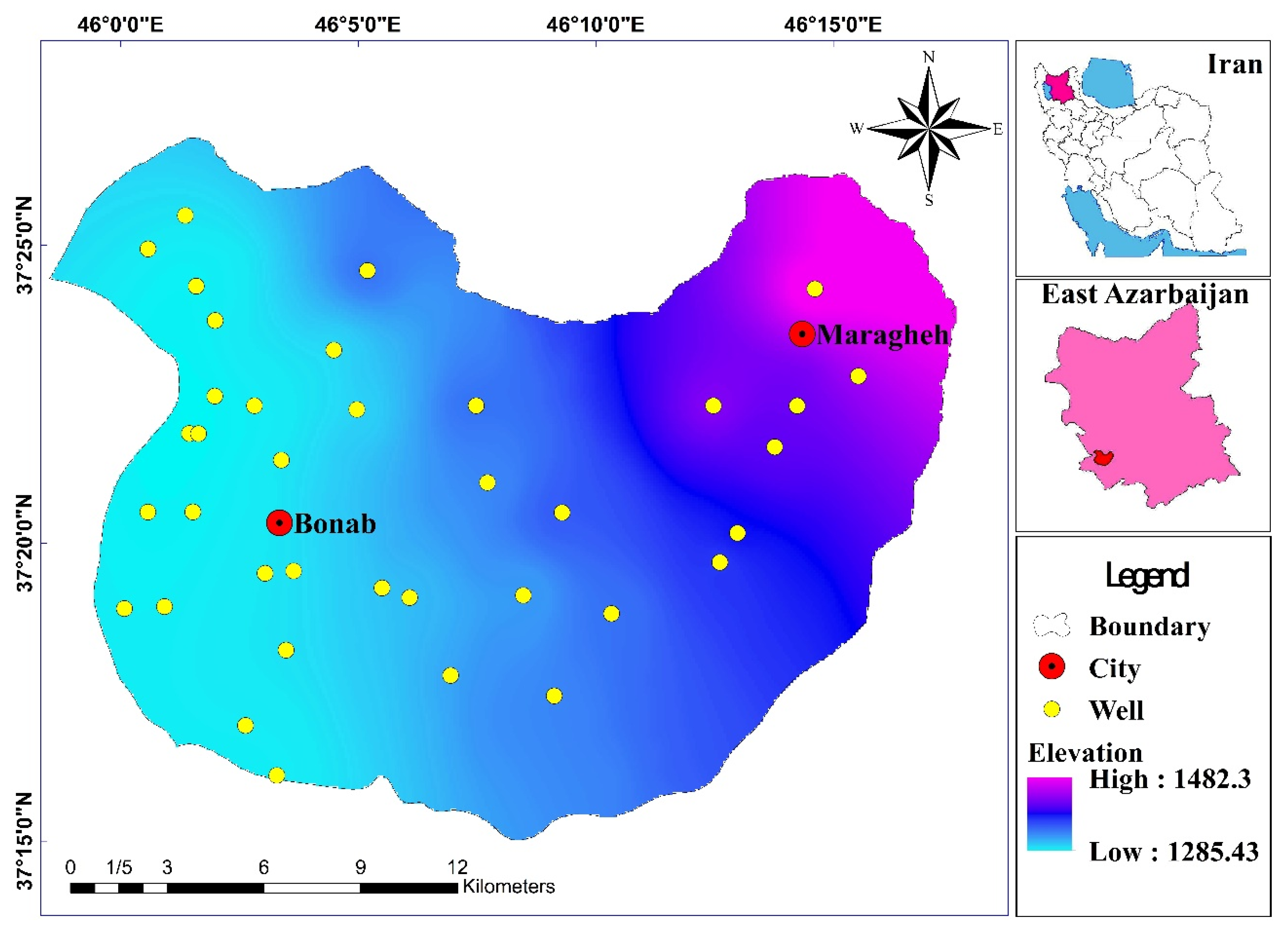
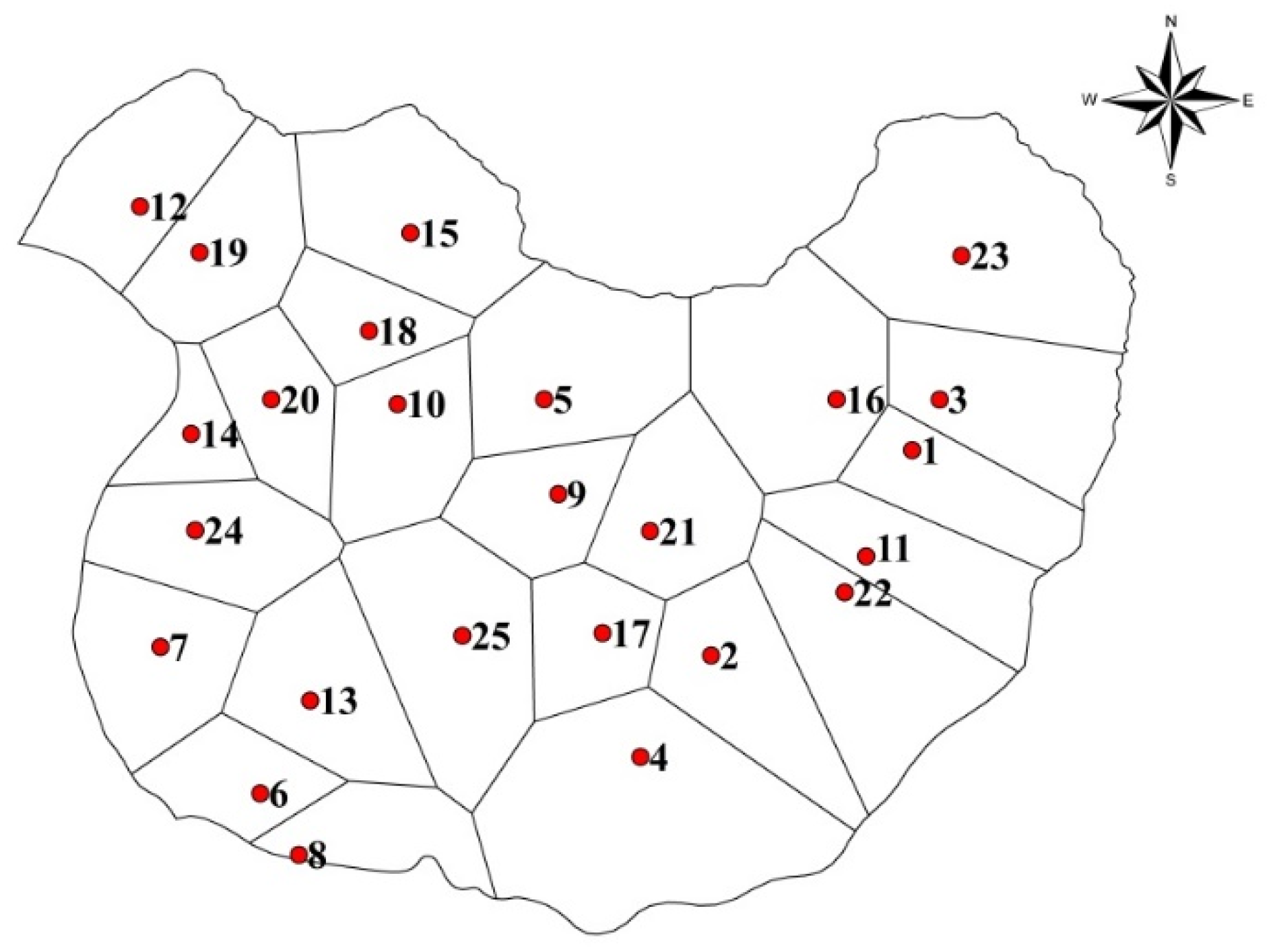


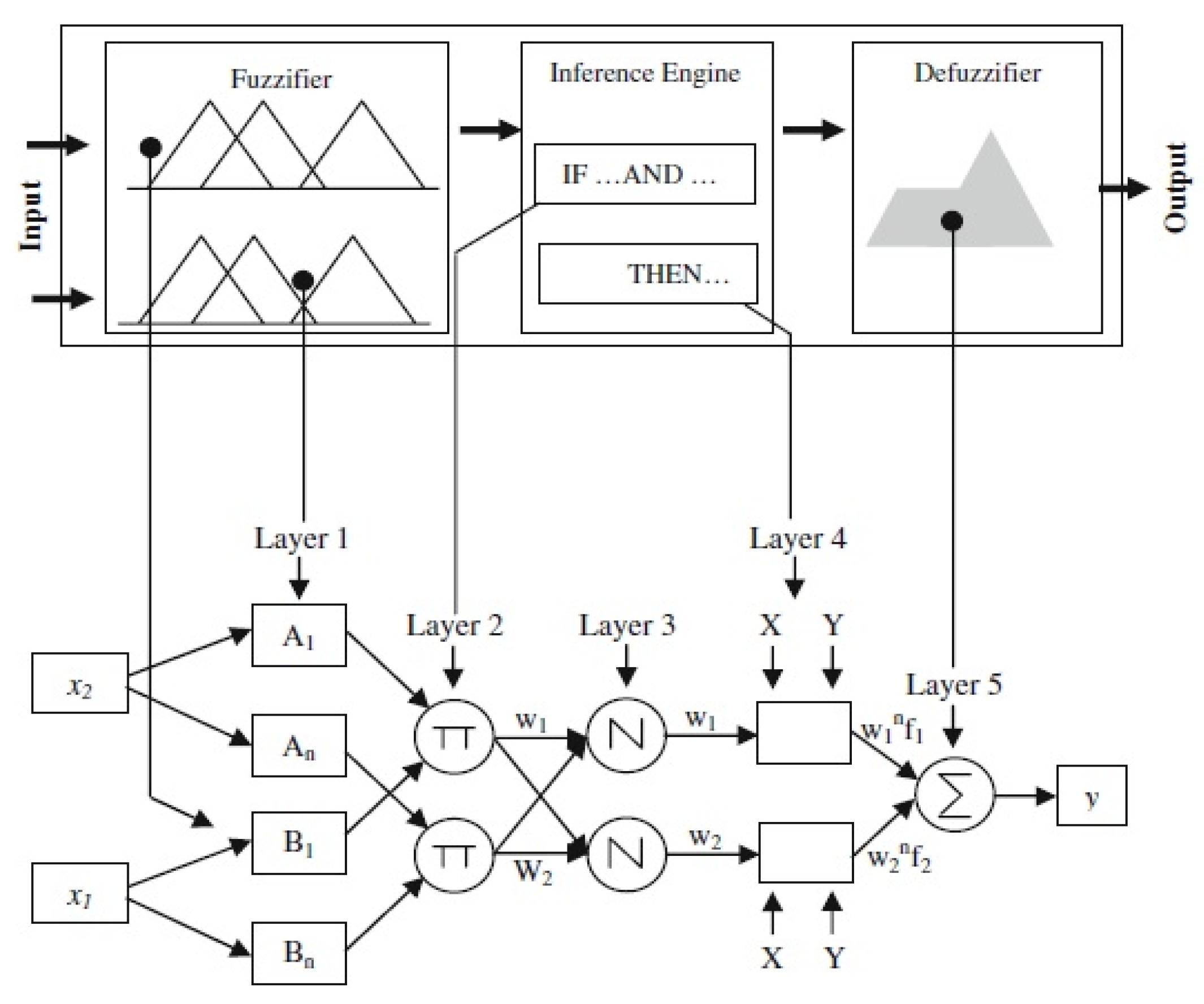
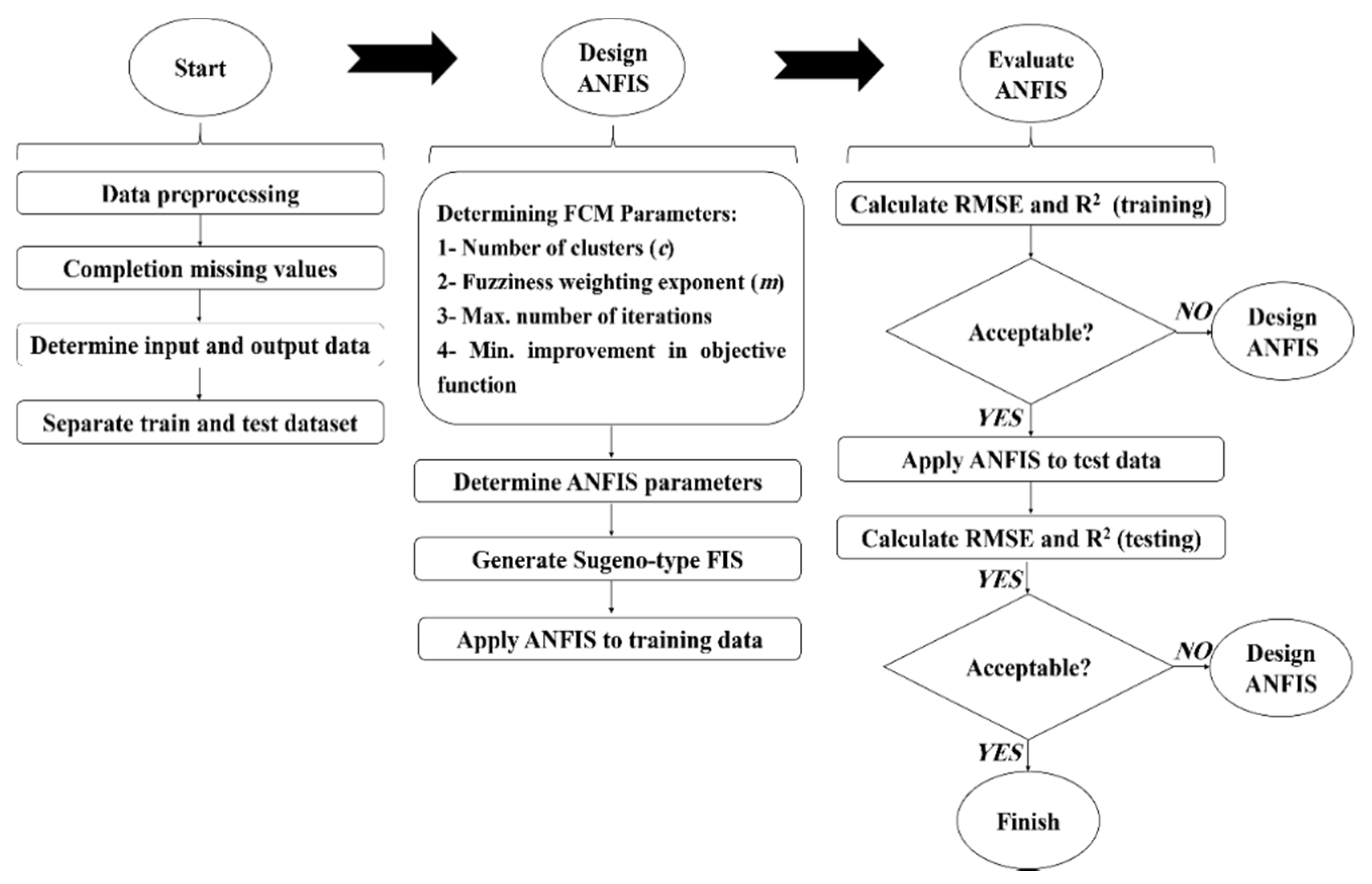
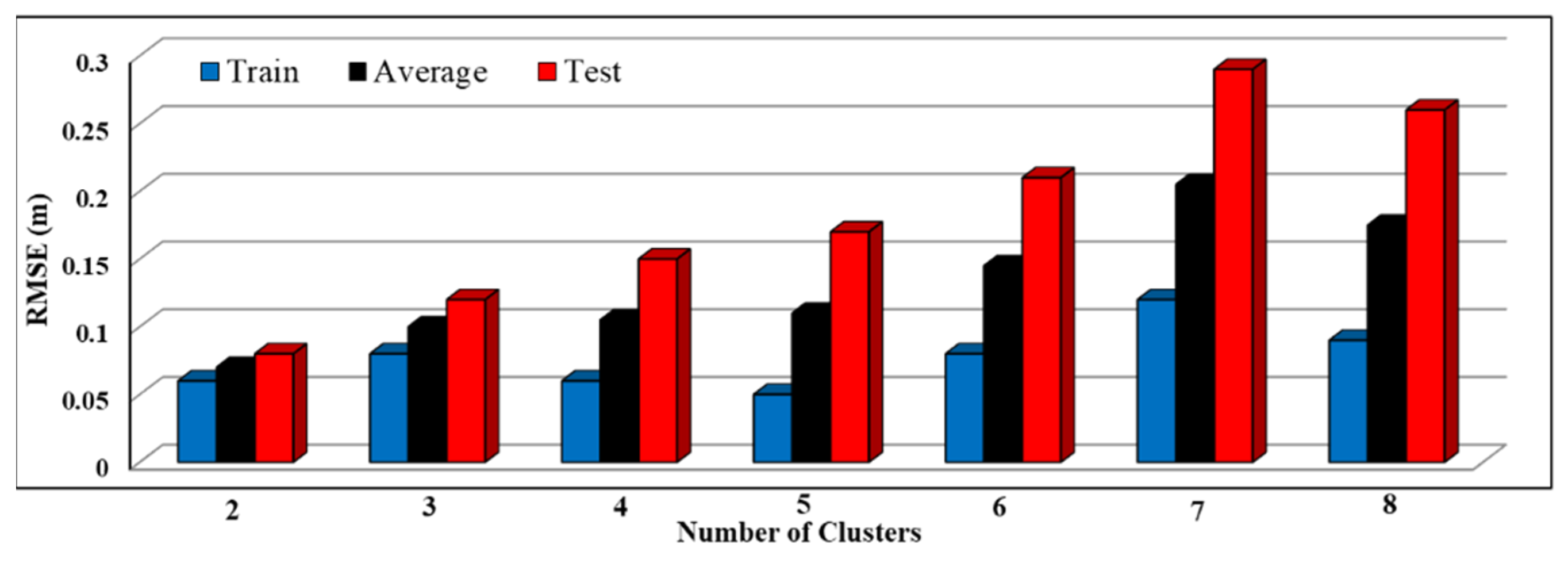
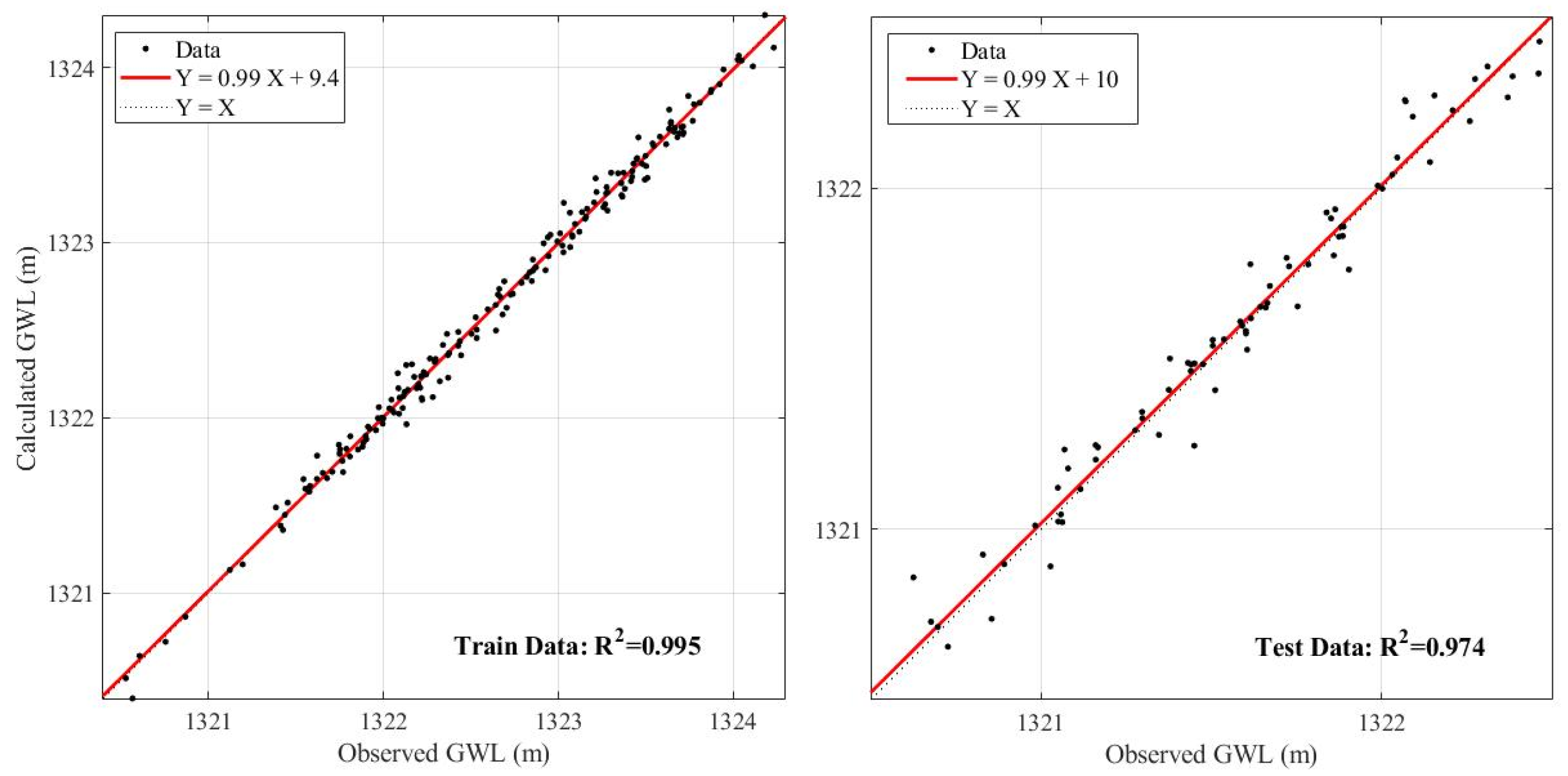
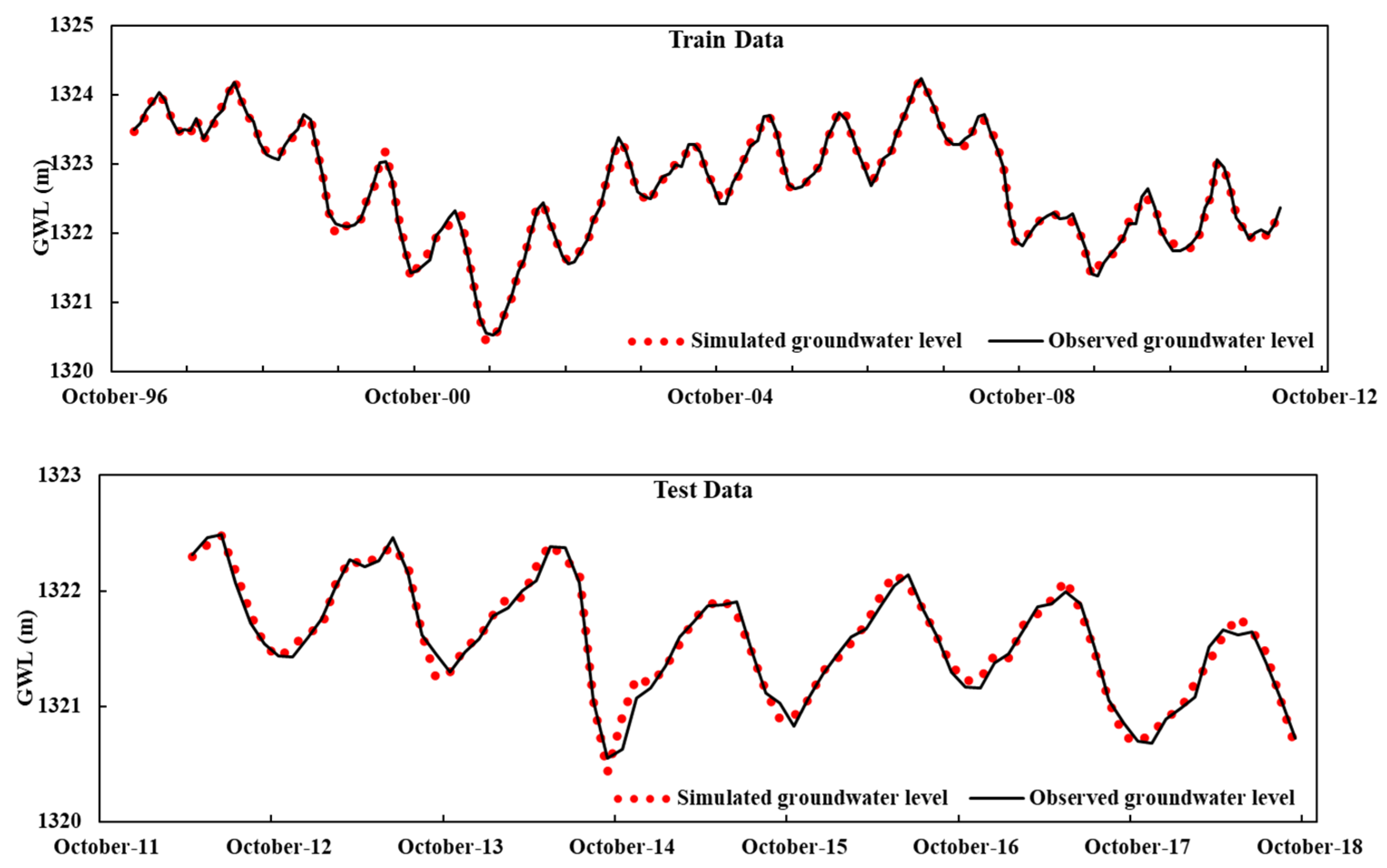
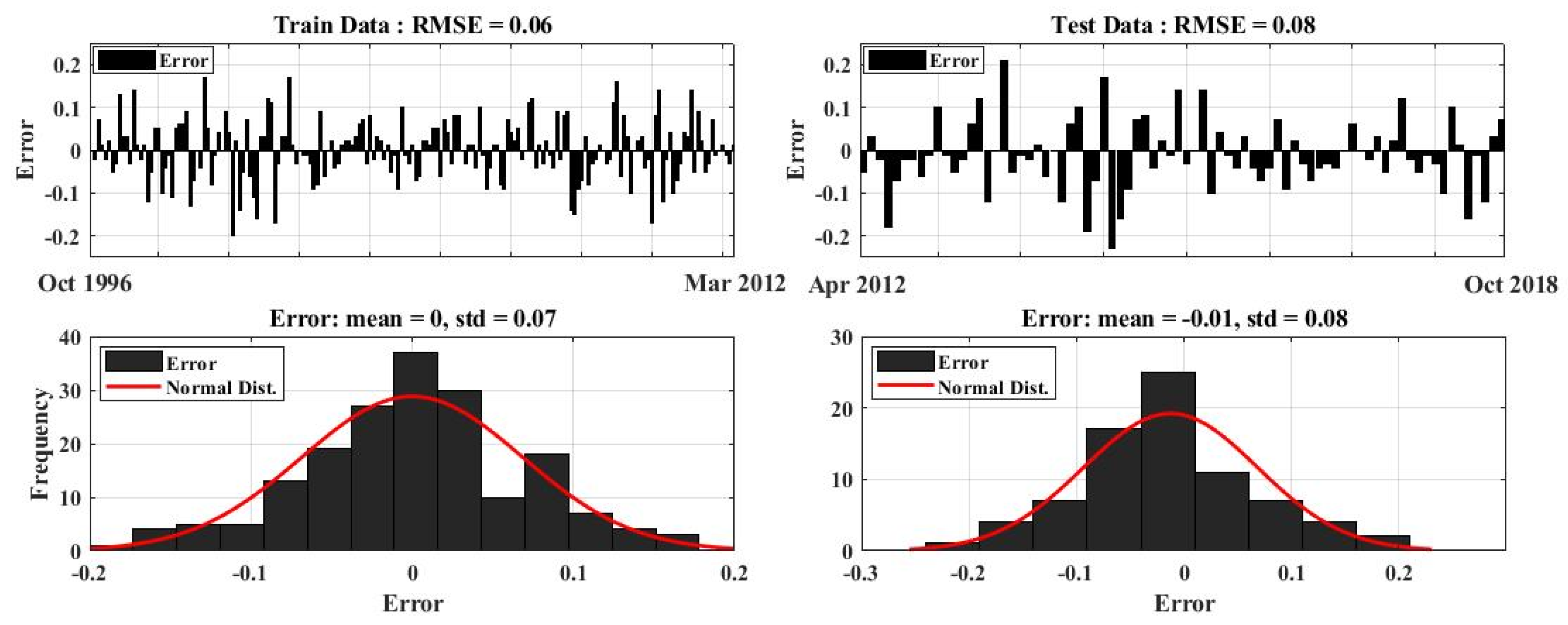
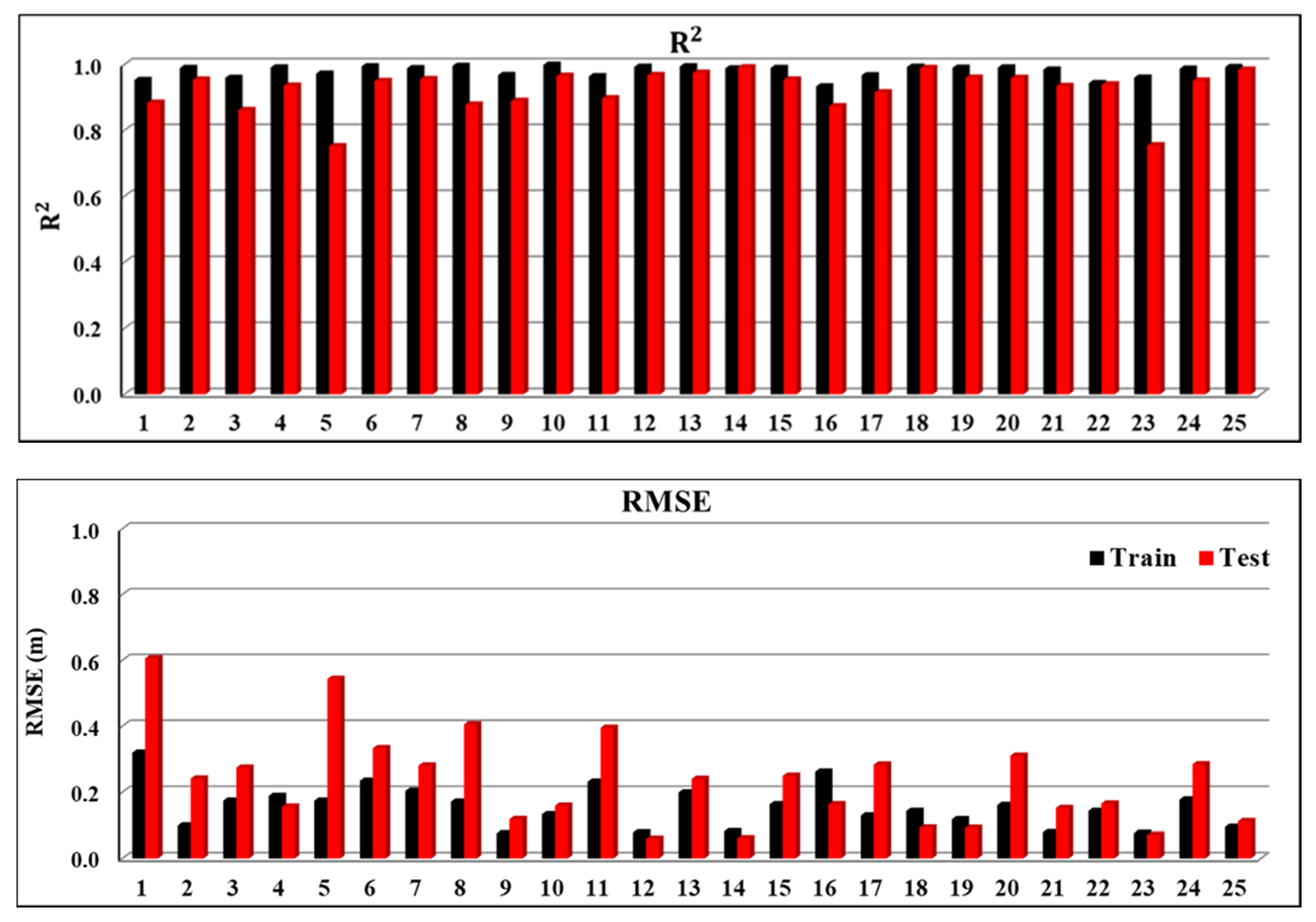
| ID | Location | A(ha) | Elevation(m) | ID | Location | A(ha) | Elevation(m) |
|---|---|---|---|---|---|---|---|
| 1 | Seraju (khoshkbarchi) | 1194 | 1397.2 | 14 | Akhond gheshlagh | 650 | 1280.58 |
| 2 | Sezavar mousavi | 1659 | 1331 | 15 | Alghou | 2099 | 1336.31 |
| 3 | Varjouy | 1801 | 1404.8 | 16 | Pahr abad | 2243 | 1413.41 |
| 4 | Yengi kand khoushe mehr | 3694 | 1327.92 | 17 | Khoushe mehr | 1007 | 1314.25 |
| 5 | Rousht bozorg istgahe rah ahan | 2096 | 1337.89 | 18 | Rousht kouchak | 921 | 1296.26 |
| 6 | Khaneh bargh ghadim | 931 | 1287.01 | 19 | Bonab energy atomi | 1527 | 1280.25 |
| 7 | Gharah chopogh behdasht | 1553 | 1285.09 | 20 | Bonab mantagheh abiyari | 1089 | 1282.14 |
| 8 | Khalilvand rouberouye ajorpazi | 998 | 1286.82 | 21 | Jadeh sarj baghal kanal | 1454 | 1345.71 |
| 9 | Maragheh foroudgah | 1094 | 1325.23 | 22 | Khanghah ghabrestan | 2126 | 1359.17 |
| 10 | Zavasht ghabrestan | 1416 | 1297.9 | 23 | Maragheh khajeh nasir | 3251 | 1474.24 |
| 11 | Varjouy maleki | 1465 | 1371.99 | 24 | Bonab aval rah darya | 1529 | 1284.25 |
| 12 | Khezerlou shourgol | 1645 | 1284.4 | 25 | Chelghay masjed | 2285 | 1305.22 |
| 13 | Zavaregh bimarestan | 1706 | 1292.36 | - | - | - | - |
| Well ID | 3 | 8 | 10 | 12 | 18 | 20 | 24 |
| Number of Missing Values | 17 | 16 | 27 | 17 | 30 | 7 | 5 |
| Method | Decomposition Level | ANFIS Inputs | Training | Testing | ||
|---|---|---|---|---|---|---|
| RMSE(m) | R2 | RMSE(m) | R2 | |||
| ANFIS | - | GLt−1,GLt−2,GLt−3 | 0.16 | 0.962 | 0.19 | 0.870 |
| Wavelet-ANFIS/haar | 1 | - | 0.11 | 0.983 | 0.14 | 0.923 |
| 2 | - | 0.11 | 0.983 | 0.14 | 0.921 | |
| 3 | - | 0.10 | 0.984 | 0.19 | 0.878 | |
| 4 | - | 0.11 | 0.983 | 0.16 | 0.891 | |
| Wavelet-ANFIS/db4 | 1 | - | 0.09 | 0.987 | 0.13 | 0.949 |
| 2 | - | 0.07 | 0.992 | 0.11 | 0.964 | |
| 3 | - | 0.07 | 0.995 | 0.08 | 0.972 | |
| 4 | - | 0.06 | 0.996 | 0.14 | 0.921 | |
| Wavelet-ANFIS/sym4 | 1 | - | 0.10 | 0.951 | 0.14 | 0.933 |
| 2 | - | 0.08 | 0.99 | 0.12 | 0.955 | |
| 3 | - | 0.06 | 0.994 | 0.09 | 0.969 | |
| 4 | - | 0.06 | 0.994 | 0.09 | 0.966 | |
| ANFIS | - | GLt−1,GLt−2,GLt−3,Pt−1,Pt−2,Pt−3,Pt−4 | 0.13 | 0.975 | 0.18 | 0.878 |
| - | - | - | - | - | ||
| Wavelet-ANFIS/haar | 1 | - | 0.09 | 0.988 | 0.16 | 0.891 |
| 2 | - | 0.09 | 0.988 | 0.13 | 0.927 | |
| 3 | - | 0.09 | 0.988 | 0.13 | 0.929 | |
| 4 | - | 0.09 | 0.988 | 0.13 | 0.925 | |
| Wavelet-ANFIS/db4 | 1 | - | 0.08 | 0.991 | 0.12 | 0.949 |
| 2 | - | 0.07 | 0.994 | 0.09 | 0.967 | |
| 3 | - | 0.06 | 0.996 | 0.09 | 0.968 | |
| 4 | - | 0.06 | 0.997 | 0.1 | 0.959 | |
| Wavelet-ANFIS/sym4 | 1 | - | 0.08 | 0.99 | 0.13 | 0.931 |
| 2 | - | 0.07 | 0.993 | 0.11 | 0.954 | |
| 3 | - | 0.06 | 0.995 | 0.08 | 0.974 | |
| 4 | - | 0.05 | 0.996 | 0.08 | 0.974 | |
Publisher’s Note: MDPI stays neutral with regard to jurisdictional claims in published maps and institutional affiliations. |
© 2020 by the authors. Licensee MDPI, Basel, Switzerland. This article is an open access article distributed under the terms and conditions of the Creative Commons Attribution (CC BY) license (http://creativecommons.org/licenses/by/4.0/).
Share and Cite
Jafari, M.M.; Ojaghlou, H.; Zare, M.; Schumann, G.J.-P. Application of a Novel Hybrid Wavelet-ANFIS/Fuzzy C-Means Clustering Model to Predict Groundwater Fluctuations. Atmosphere 2021, 12, 9. https://doi.org/10.3390/atmos12010009
Jafari MM, Ojaghlou H, Zare M, Schumann GJ-P. Application of a Novel Hybrid Wavelet-ANFIS/Fuzzy C-Means Clustering Model to Predict Groundwater Fluctuations. Atmosphere. 2021; 12(1):9. https://doi.org/10.3390/atmos12010009
Chicago/Turabian StyleJafari, Mohammad Mahdi, Hassan Ojaghlou, Mohammad Zare, and Guy Jean-Pierre Schumann. 2021. "Application of a Novel Hybrid Wavelet-ANFIS/Fuzzy C-Means Clustering Model to Predict Groundwater Fluctuations" Atmosphere 12, no. 1: 9. https://doi.org/10.3390/atmos12010009
APA StyleJafari, M. M., Ojaghlou, H., Zare, M., & Schumann, G. J.-P. (2021). Application of a Novel Hybrid Wavelet-ANFIS/Fuzzy C-Means Clustering Model to Predict Groundwater Fluctuations. Atmosphere, 12(1), 9. https://doi.org/10.3390/atmos12010009







